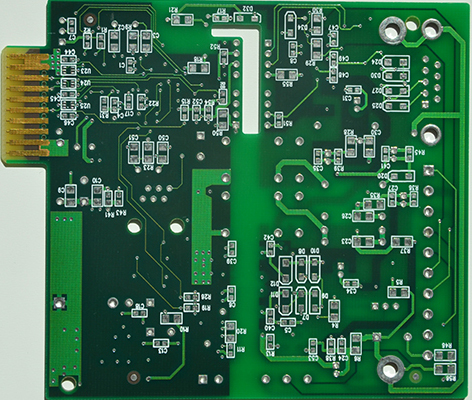OSP (Organic Solderability Preservative) is probably the most eco-friendly
surface finish that requires simple process and low cost brings its wide usage in PCB production. OSP is a process to generate a layer of organic film over clear bare copper in chemical way. This layer of organic film is resistant to oxidation, thermal shock and wetting , which protect the copper surface from rust under normal environment. Meanwhile, it could also be easily removed in the subsequent high temperature welding for better soldering.
Advantage: the simplicity of the process, a flat surface and a low cost.
Cons:
sensitive to storage and heat cycles, also not ideal for plated vias.
HASL or HASL LF (lead free), Hot Air Levelling is still one of the most popular surface
finish choices. But, in recent years, it has lost some of its shine, as
manufacturers have realized its limitations. More complex products, higher
level of integration, triggered the development of smaller components and the
need for smaller traces, smaller pads and higher density PCBs. HASL leaves
uneven surfaces that are not suitable for fine pitch components.
Advantage: good
solderability and low cost Cons: uneven surfaces, which might make it difficult
to assemble fine pitch components.

ENIG (Electroless Nickel Immersion Gold) or Immersion Gold or Cheminical Gold has widely replaced ‘Flash Gold’ (electro), which was so widely
used in the 1990s in Asia. ENIG has become ‘the’ surface finish of
reference for multi-layers PCB and fine pitch boards. Note: the components are
soldered on the nickel; gold is only present to protect the former one.
Advantage: smooth & flat surface, good wetting, multiple heat shock, storage
time.
Cons: black pads and cost
ENEPIG (Electroless Nickel / Electroless Palladium / Immersion Gold) is a
similar process to ENIG, though we add a layer of palladium to prevent the
nickel to oxidise.
Advantage: perfect for Al or Au wire bonding
Con: high cost

Immersion Tin (Chemical Tin) Chemical Sn is getting more popular.
Immersion Tin surface is adopted for its good flatness and lead free nature. However, Cu/Sn intermetallic compounds with poor solderability are easily generated in the process. The biggest weakness of immersion tin surface is its short life, especially when stored in high temperature and high humidity environment, Cu/Sn intermetallic compounds will increase until the loss of solderability.
Pros: flat surface, good wetting, and multiple heat shock, ideal for pressfit
and backplane applications.
Cons: must be handled carefully and whiskers.
Chemical Silver (Immersion Silver) The immersion silver process is relatively simple and fast. There is no need to apply a thick layer of armor to the PCB board, but also provides good electrical and solderability for the PCB board in a hot, wet and polluted environment. The disadvantage is that it will lose its luster. And it also has good storage property. Immersion silver is a
good alternative to ENIG.
Advantage: uniform layer, good wetting, ideal for silver wire bonding.
Cons: oxidation by sulphur presence, silver whiskering
